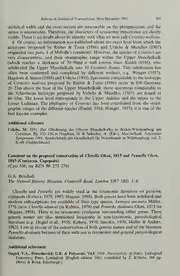
Comment On The Proposed Conservation Of Clavella Oken, 1815 And Pennella Oken, 1815 (Crustacea, Copepoda) PDF
Preview Comment On The Proposed Conservation Of Clavella Oken, 1815 And Pennella Oken, 1815 (Crustacea, Copepoda)
BulletinofZoologicalNomenclature50(4)December1993 285 umbilicalwidthandthecrosssectionaremeasurableonthephragmocone,andthe sutureisuncorroded.Therefore,thecharactersoftaxonomicimportanceareclearly visible.ThereisnodoubtaboutitsidentitywithwhatwenowcallCeratitesnodosus. 4. Ofcourse,noinformationwaspublishedabouttheexactlevelfromwhichthe lectotypes proposed by Rieber & Tozer (1986) and Urlichs & Mundlos (1987) originated(seepara.4ofMelville'scomment).However,thespeciesofCeratitesare very characteristic, and their stratigraphic range within the Upper Muschelkalk (which reaches a thickness of 70-90m) is well known since Riedel (1916), who subdivided the Upper Muschelkalk into 10 Ceratites Zones. This subdivision has often been confirmed and completed by different authors, e.g. Wenger (1957), Hagdorn&Simon(1985)andUrlichs(1993).Specimenscomparabletothelectotype of Ceratites nodosus proposed by Rieber & Tozer (1986) occur in SW-Germany 20-23mabovethebaseoftheUpperMuschelkalk; thosespecimenscomparableto the Schlotheim lectotype proposed by Urlichs & Mundlos (1987) are found at 60-65m. The lower level corresponds to the Upper Anisian and the upper to the Lower Ladinian. The phylogeny ofCeratites has been established from the strati- graphicrangesofthedifferentspecies(Riedel, 1916;Wenger, 1957);itisoneofthe bestknownexamples. Additionalreference Urlichs, M. 1993. Zur GHederung des Oberen Muschelkalks in Baden-Wiirttemberg mit Ceratiten. Pp. 153-156inHagdorn, H.&Seilacher,A. (Eds.), Muschelkalk, Schonlaler Symposium1991.SonderbandederGesellschaftfurNaturkundeinWurttemberg,vol.2. Kerb(Goldschneck). CommentontheproposedconservationofClavellaOken, 1815andPennellaOken, 1815(Crustacea,Copepoda) (Case836;see BZN50:273-276) G.A. Boxshall TheNaturalHistoryMuseum. CromwellRoad, LondonSW75BD, U.K. Clavella and Pennella are widely used in the taxonomic literature on parasitic copepods(Kabata, 1979, 1992;Hogans, 1988).Bothgenerahavebeenredefinedand modern redescriptionsareavailableoftheirtypespecies, Lernaeauncinata Miiller, 1776(nowClavellaadunca)(inKabata, 1979)andPennelladiodontisOken, 1815(in Hogans, 1988). There is no taxonomic confusion surroundingeither genus. These generic names are also mentioned frequently in non-taxonomic, parasitological literature(e.g. Dogielet al., 1958; Kabata, 1970; Sniesko, 1970; Moller& Anders, 1983).Iaminfavouroftheconservationofbothgenericnamesandofthebinomen Pennelladiodontisbecauseoftheirwideuseintaxonomicandgeneralparasitological literature. Additionalreferences Dogiel,V.A.,Petrushevskii,G.K.& Polyanski,Yu.I. 1958. Parasitologyoffishes.Leningrad University Press, Leningrad. [English edition 1961, translated by Z. Kabata. 384 pp. Oliver&Boyd,Edinburgh.] 286 BulletinofZoologicalNomenclature50(4)December1993 Kabata, Z. 1970. Diseasesoffishes. Book I. Crustaceaasenemiesoffishes, 171 pp.T.F.H. Publications,JerseyCity. Kabata,Z. 1992.Copepodsparasiticonfishes.SynopsesoftheBritishFauna,(n.s.)47: 1-264. Moller,H.& Anders,K. 1983. KrankheilenundParasitenderMeeresfische.258pp.Author, Kiel. Sniesko, S.F. 1970. A symposium on diseases offishes andshellfishes. Special Publication No. 5.526pp.AmericanFisheriesSociety,Washington. CommentontheproposaltoconserveOecotheaHalidayinCurtis, 1837andto designateHelomyzafenestralisasthetypespecies(Insecta,Diptera) (Case2836;seeBZN50:44^7,235-236) CurtisW. Sabrosky 205 MedfordLeas. Medford. NewJersey08055. U.S.A. IsupportheartilytheapphcationbyWoznica&ZatwarnickionOecotheaHahday forrestoringvaUditytoitsover-a-centuryusage. Thompson & Mathis (1980), in their thorough and commendable study ofthe genericnamesofHalidayinCurtis(1837),erred,inmyopinion,intheirtreatmentof included speciesofOecothea. Theirdesignated typespecies,whileconcordantwith their view of included species and the problems with these, left the long-used Oecotheaofauthorswithoutaname(latersuppliedbyPeterson&Gill,1982,butnot widelyaccepted). Thedisputedproblemisnotavailability,wellelucidatedbyThompson&Mathis (1980),butthetypespecies,andthecruxofthisproblemiswhatspecies,ifany,was orwereoriginallyincluded.Undertheplenarypowers,ofcourse,anyspeciescanbe designatedastype,whetherornotoriginallyincluded. Mycatalogueoffamily-groupnamesin Diptera, nearingcompletion,containsa detailedanalysisofspeciesnumbersandposition forOecothea. Idonotagreewith Thompson & Mathis (1980) that the four species following Oecothea in Curtis's Addenda were necessarily originally included. Indeed, we have Haliday's(1838, p. 187)ownnearlycontemporaneoustestimonythattheywerenot.Theimportanceof thispaper,entitledNewBritishinsectsindicatedinMr. Curtis'sGuide,isthatitisthe author'sexplanationofhisownnames, merelylistedinCurtis'swork; hisnotefor subgenusAecothea[sic]reads;'H[elomy:a]fenestralisistheonly[italicsmine]British species'. In my view, the pragmatic conclusion, considering only the 1837 Guide, would have been that Oecothea in 1837 was ambiguous and without clearly associatedspecies, andthatthetypewasH.fenestralisbysubsequentmonotypyin 1838. ButthedesignationbyThompson&Mathis(1980)hascausedrecoursetothe Commission,whichtheapplicantshavenowprovided. A minor detail concerns Aecothea Haliday, 1838. Thompson & Mathis (1980) considered this to be an unjustified emendation ofOecothea. The applicants have suggested thatitwas'adeliberatetransliterationofGreek',whichwouldstillbean unjustified emendation. However, there is, strictly speaking, no evidence ofemen- dationand nomenclaturallyAecotheamustbeconsideredanerroneoussubsequent spelling.
